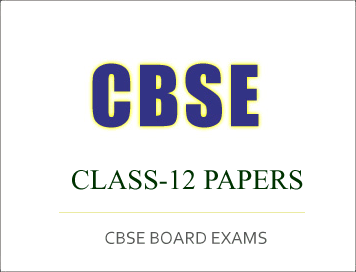CBSE Class-12 Exam 2017 : All India Scheme Question Paper, Biology Ophthalmic
Disclaimer: This website is NOT associated with CBSE, for official website of CBSE visit - www.cbse.gov.in
CBSE Class-12 Exam 2017 : All India Scheme
Question Paper, Biology Ophthalmic
CBSE Class-12 Exam 2017 : Biology Ophthalmic
- कृपया जाँच कर लें कि इस प्रश्न-पत्र में मुद्रित पृष्ठ 5 हैं ।
- प्रश्न-पत्र में दाहिने हाथ की ओर दिए गए कोड नम्बर को छात्र उत्तर-पुस्तिका के मुख-पृष्ठ पर लिखें ।
- कृपया जाँच कर लें कि इस प्रश्न-पत्र में 12 प्रश्न हैं ।
- कृपया प्रश्न का उत्तर लिखना शुरू करने से पहले, प्रश्न का क्रमांक अवश्य लिखें ।
- इस प्रश्न-पत्र को पढने के लिए १५ मिनट का समय दिया गया है । प्रश्न-पत्र का वितरण पूर्वाङ्घ में १०.१५ बजे किया जाएगा । १०.१५ बजे से १०.३० बजे तक छात्र केवल प्रश्न-पत्र को प‹ढेंगे और इस अवधि के दौरान वे उत्तर-पुस्तिका पर कोई उत्तर नहीं लिखेंगे ।
- Please check that this question paper contains 5 printed pages.
- Code number given on the right hand side of the question paper should be written on the title page of the answer-book by the candidate.
- Please check that this question paper contains 12 questions.
- Please write down the Serial Number of the question before attempting it.
- 15 minute time has been allotted to read this question paper. The question paper will be distributed at 10.15 a.m. From 10.15 a.m. to 10.30 a.m., the students will read the question paper only and will not write any answer on the answer-book during this period.
जैविकी नेत्रविज्ञान
BIOLOGY OPHTHALMIC
निर्धारित समय : 2 घण्टे, अधिकतम अंक : 30
Time allowed : 2 hours, Maximum Marks : 30
भाग क
SECTION A
सामान्य निर्देश :
(i) किन्हीं दस प्रश्नों के उत्तर दीजिए ।
(ii) सभी प्रश्नों के अंक समान हैं ।
(i) किन्हीं दस प्रश्नों के उत्तर दीजिए ।
(ii) सभी प्रश्नों के अंक समान हैं ।
General Instructions :
(i) Attempt any ten questions.
(ii) All questions carry equal marks.
(i) Attempt any ten questions.
(ii) All questions carry equal marks.
१. (क) संयुक्त सूक्ष्मदर्शी (कंपाउंड माइक्रोस्कोप) के विभिन्न अंग क्या-क्या हैं ? समझाइए कि इस सूक्ष्मदर्शी (माइक्रोस्कोप) का उपयोग करने से हमें आवर्धित प्रतिqबब कैसे प्राप्त
होता है । २
(ख) प्रतिकृति (रिप्लिकेशन) और प्रतिलिपि (ट्रांसक्रिप्शन) के बीच क्या अंतर है ? १
(a) What are the various parts of a compound microscope ? Explain how we get magnified image using this microscope.
(b) What is the difference between replication and transcription ?
होता है । २
(ख) प्रतिकृति (रिप्लिकेशन) और प्रतिलिपि (ट्रांसक्रिप्शन) के बीच क्या अंतर है ? १
(a) What are the various parts of a compound microscope ? Explain how we get magnified image using this microscope.
(b) What is the difference between replication and transcription ?
२. किसी पादप या जंतु कोशिका के किन्हीं तीन कोशिकांगों के नाम लिखिए और उनके प्रकार्यों का वर्णन कीजिए । ३
Name any three organelles of a plant or animal cell, and describe their functions.
३. (क) मेंडल ने उद्यान मटर के साथ प्रजनन के प्रयोग किए जिसमें उसने ऊँचे पौधों को बौने पौधों से संकर कराया । दूसरी पी‹ढी ऋ२ में उसे जो अनुपात मिला वह था
१ : २ : १. इस अनुपात की व्याख्या कीजिए ।
(ख) निम्नलिखित में से कौन-सा अन्य दूसरों से मेल नहीं खाता ? कारण लिखिए ।
(i) कोशिका झिल्ली, टोनोप्लास्ट, केंद्रक
(ii) ऐडेनीन, पेप्सिन, रेनिन
(iii) कोशिका-भित्ति, हरितलवक (क्लोरोप्लास्ट), तारककेन्द्र (सेंट्रियोल)
(a) Mendel conducted a breeding experiment with garden pea where
he crossed tall plants with dwarf plants. In the second generation
F2, the ratio he got was 1 : 2 : 1. Explain the ratio.
(b) Which one of the following does not match with the other two ?
Write the reason.
(i) Cell membrane, Tonoplast, Nucleus
(ii) Adenine, Pepsin, Renin
(iii) Cell wall, Chloroplasts, Centrioles
he crossed tall plants with dwarf plants. In the second generation
F2, the ratio he got was 1 : 2 : 1. Explain the ratio.
(b) Which one of the following does not match with the other two ?
Write the reason.
(i) Cell membrane, Tonoplast, Nucleus
(ii) Adenine, Pepsin, Renin
(iii) Cell wall, Chloroplasts, Centrioles
